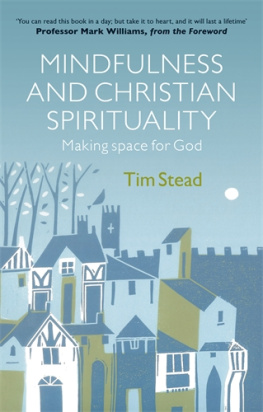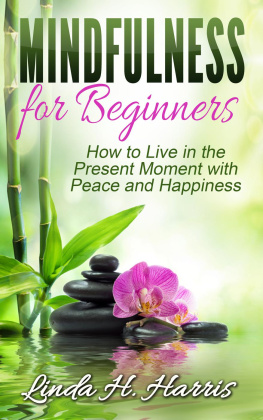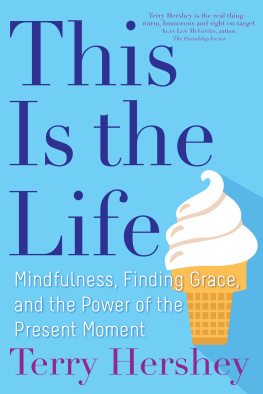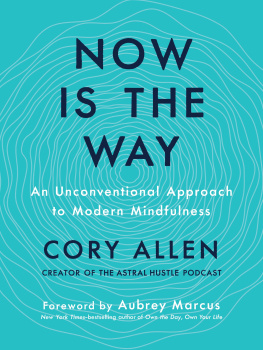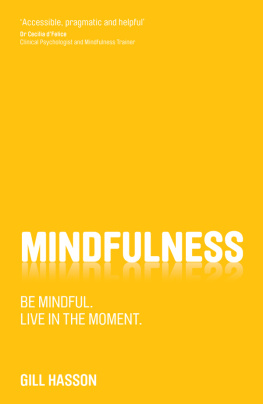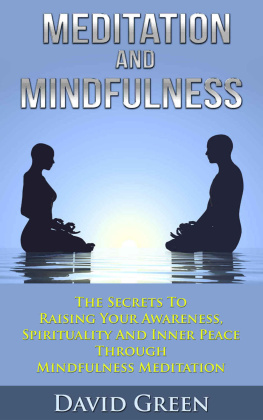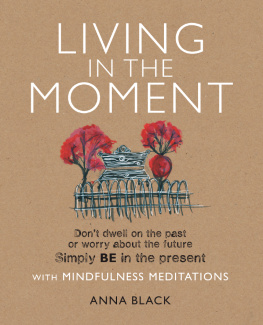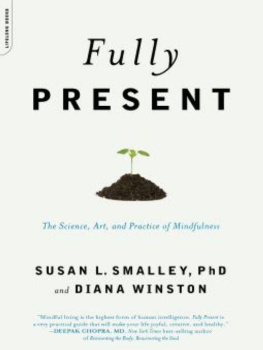Tim Stead graduated with an engineering degree in 1982, has been an ordained Anglican priest for 20 years and is currently Vicar of Holy Trinity, Headington Quarry, Oxford. He is an accredited mindfulness teacher with the Oxford Mindfulness Centre and teaches their eight-week Mindfulness Based Cognitive Therapy (MBCT) course as well as running mindfulness courses and retreats in the parish and for clergy in the diocese.

If you already know the basics of mindfulness, or have even completed a course, then you might want to skip this chapter (although, equally, you might just be interested in my own slant). But for those who dont have a basic knowledge, this chapter covers how mindfulness has emerged in the past 40 years (first in clinical settings and lately in all sorts of mainstream contexts), what it actually is, how it is taught generally and how I have been teaching it in the parish context.
History
The story goes back to the 1970s when Jon Kabat-Zinn, with a PhD in molecular biology from the Massachusetts Institute of Technology, began to develop a meditation-based programme to help support people suffering from chronic pain. Kabat-Zinn had been introduced to the practice of meditation a few years earlier and was influenced by the world-renowned Buddhist teacher Thich Nhat Hahn, among others. Kabat-Zinn was born Jewish but suggests that his world view was more strongly formed by the science and art learned from his parents than by any religious context. Similarly, when he discovered meditation it was not the religious aspects that drew him but the health value of the practices. He does not identify as a Buddhist any more than he identifies as a Jew, but rather has explored all that he has been exposed to in relation to his own scientific context. So, when he began to realize that the practices he was engaging with might have some significant health benefits, he developed an eight-week programme that later became known as Mindfulness Based Stress Reduction (MBSR). He offered this in the University of Massachusetts Medical School and demonstrated through controlled tests that the course could significantly reduce anxiety and stress in patients, and in particular help people to find an alternative way of managing chronic pain. The programme has been running ever since and is now available all over the world.
There is a very moving video, Healing and the Mind (available on YouTube), of Kabat-Zinn teaching a class of people with severe, untreatable chronic pain of all kinds, showing how the practices helped to transform the lives of the participants. These patients had already exhausted all the possibilities provided by conventional medicine for elimination of their pain. Mindfulness practice was not being offered as another way to eliminate pain, however. Instead, MBSR taught the participants a new way of relating to their pain. This reduced the considerable degree of stress with which most people usually respond to pain, and this, in turn, reduced the perceived experience of pain to the extent that many could take fewer painkillers, and often either go back to work or engage in activities they had previously withdrawn from. But the most striking thing about the video, which seems to me particularly important to note, is the compassion that seems to flow from the teacher. Kabat-Zinn appears genuinely to care for his patients in a heartfelt way. If, as Kabat-Zinn says, this is really all science, then it was science with a difference, because it included as a necessary fundamental element the lived-out experience of love.
Fast-forward to the 1990s and we find a group of cognitive behaviour therapists on two continents reflecting on the effectiveness of their treatment for long-term sufferers of depression. Recall that, up until then, psychiatry and psychology had been focusing on how to treat depression once people were already in the midst of an episode. Cognitive behaviour therapy (CBT) had been shown to have been a very successful treatment since the 1970s, but what Mark Williams, John Teasdale and Zindel Segal were finding was that a major problem for people with depression was that it keeps coming back it is a recurrent problem especially for those treated with antidepressant medication. These psychologists thought that such recurrence might be due to the fact that, for many who have suffered past episodes of depression, a new episode is more and more easily triggered. For these people, any small initial low mood could activate a whole chain of associations, forming into negative thought patterns that then compound and deepen the mood into a full-blown depression. CBT was known to help reduce recurrence, but no one knew how it had its therapeutic effects. Segal, Williams and Teasdale suggested that CBT had implicitly been teaching people a way to step back from the vicious cycle of their thoughts rather than constantly getting caught up in them. If this is how successful treatment actually worked, could the same skill be taught to those who were known to be vulnerable to future depression even when they were well? But how could this be achieved? It was at this time that they became aware of Kabat-Zinns work in Massachusetts, through his publications, which had begun to emerge in the early 1990s.
So, the CBT experts travelled to America, took part in the MBSR programme and came to realize that this could be the missing piece to their own jigsaw. After one or two false starts, most notably making the mistake of thinking that mindfulness could be taught by people who were not actually practising it themselves, they developed an eight-week programme called Mindfulness Based Cognitive Therapy (MBCT). This was based heavily on the MBSR programme but was adapted to focus on the needs of long-term sufferers of depression. CBT was still in there, as it had been shown to be so effective in the past, but it was now front-loaded with mindfulness. Essentially, participants were shown a way of disengaging from their negative thought processes in order to create space around them before then employing some gentle CBT techniques.
The initial results were dramatic. Compared to control groups who continued with treatment as normal (that is, continuing with whatever their usual treatment might be, including going back to medication if they needed to), those who took part in the MBCT programme showed a reduction in episodes of relapse by up to 50 per cent. And it seems to be reduction in relapse for chronic sufferers that is the key achievement. It is generally advised that sufferers of depression take part in an MBCT programme, if possible while they are feeling well. This is partly because the programme is quite demanding in itself and partly because but what it teaches is the skills needed to avoid relapse. Once again it is important to note that compassion is built into the way the programme is taught. Those who have developed the course have been motivated over the decades by their sense of compassion and have realized that this is a key part of the healing process. A final point to note is that, partly because of these initial results and partly because of the unit costs involved (mindfulness can be taught to a group of up to 25 people at a time), NICE (the national body that advises the NHS) were fairly quickly persuaded to back it. You can now be referred by your GP to a mindfulness course, paid for by the NHS.
A definition
So, an extraordinary success story! Mindfulness is a good thing, as declared by psychologists, neuroscientists and health professionals. But what actually is it and how is it taught?
First, a definition: mindfulness can be described as being more fully aware of your own experience in the present moment in a non-judgemental way . There are four vital strands to this definition: awareness, experience, the present moment, and non-judgement; all are key parts of what mindfulness is. It may sound very simple or even naive to suggest that bringing mindful awareness to things would have any significant effect on the practitioner, but notice how each of these four aspects is counterintuitive against the grain of much of our regular default brain activity and therefore needs a great deal of practice to achieve; and that each aspect plays a significant role in reducing anxiety and living more freely, which consequently seems to have such an effect on many other aspects of our health.
Next page
